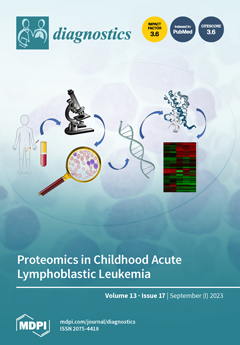Open AccessArticle
Preoperative Assessment of Perianal Fistulas with Combined Magnetic Resonance and Tridimensional Endoanal Ultrasound: A Prospective Study
by
Nikolaos Varsamis, Christoforos Kosmidis, Grigorios Chatzimavroudis, Fani Apostolidou Kiouti, Christoforos Efthymiadis, Vasilis Lalas, Chrysi Maria Mystakidou, Christina Sevva, Konstantinos Papadopoulos, George Anthimidis, Charilaos Koulouris, Alexandros Vasileios Karakousis, Konstantinos Sapalidis and Isaak Kesisoglou
Cited by 7 | Viewed by 3729
Abstract
Background: we designed a prospective study of diagnostic accuracy that compared pelvic MRI and 3D-EAUS with pelvic MRI alone in the preoperative evaluation and postoperative outcomes of patients with perianal fistulas. Methods: the sample size was 72 patients and this was divided into
[...] Read more.
Background: we designed a prospective study of diagnostic accuracy that compared pelvic MRI and 3D-EAUS with pelvic MRI alone in the preoperative evaluation and postoperative outcomes of patients with perianal fistulas. Methods: the sample size was 72 patients and this was divided into two imaging groups. MRI alone was performed on the first group. Both MRI and 3D-EAUS were performed in parallel on the second group. Surgical exploration took place after two weeks and was the standard reference. Park’s classification, the presence of a concomitant abscess or a secondary tract, and the location of the internal opening were recorded. All patients were re-evaluated for complete fistula healing and fecal incontinence six months postoperatively. All of the collected data were subjected to statistical analysis. Results: the MRI group included 36 patients with 42 fistulas. The MRI + 3D-EAUS group included 36 patients with 46 fistulas. The adjusted sensitivity and negative predictive value were 1.00 for most fistula types in the group that underwent combined imaging. The adjusted specificity improved for intersphincteric fistulas in the same group. The adjusted balanced accuracy improved for all fistula types except rectovaginal. The combination of imaging methods showed improved diagnostic accuracy only in the detection of a secondary tract. The healing rate at six months was 100%. Fecal incontinence at six months did not present a statistically significant difference between the two groups (Fisher’s exact test
p-value > 0.9). Patients with complex perianal fistulas had a statistically significant higher probability of undergoing a second surgery (x
2 test
p-value = 0.019). Conclusions: the combination of pelvic MRI and 3D-EAUS showed improved metrics of diagnostic accuracy and should be used in the preoperative evaluation of all patients with perianal fistulas, especially those with complex types.
Full article
►▼
Show Figures






